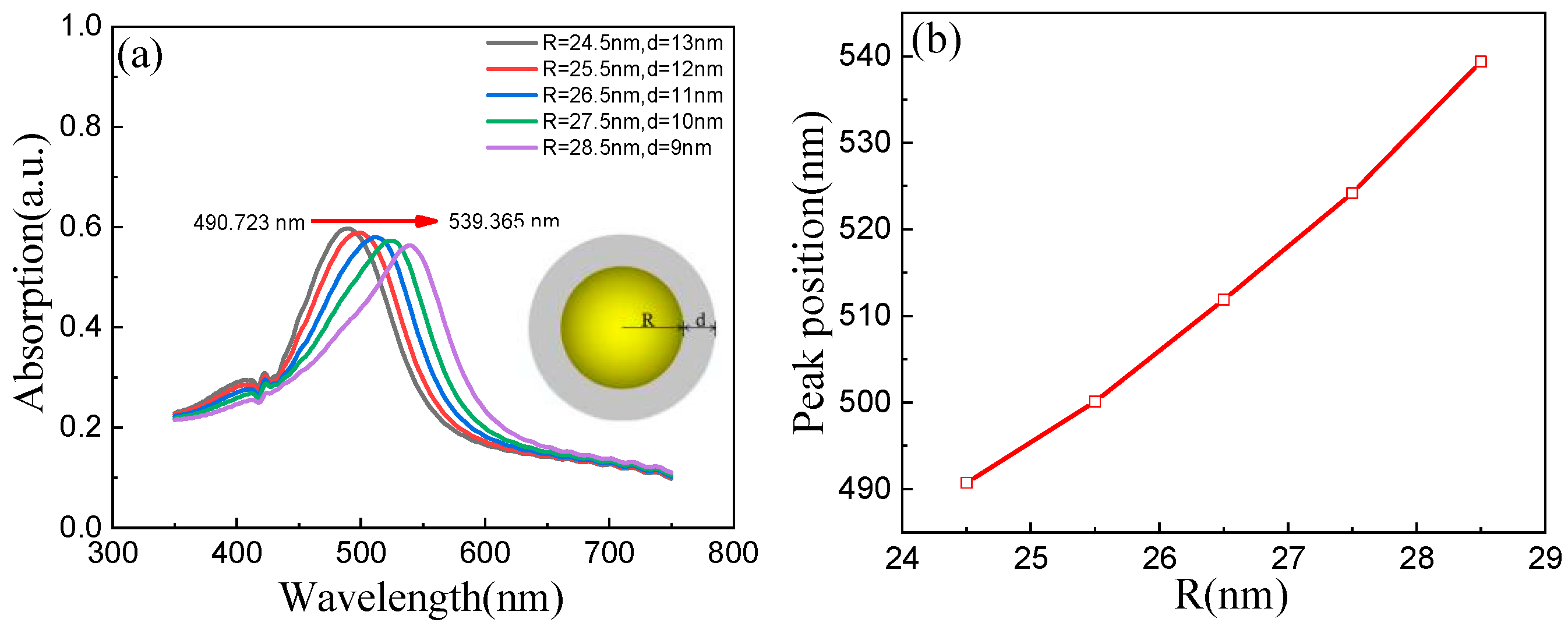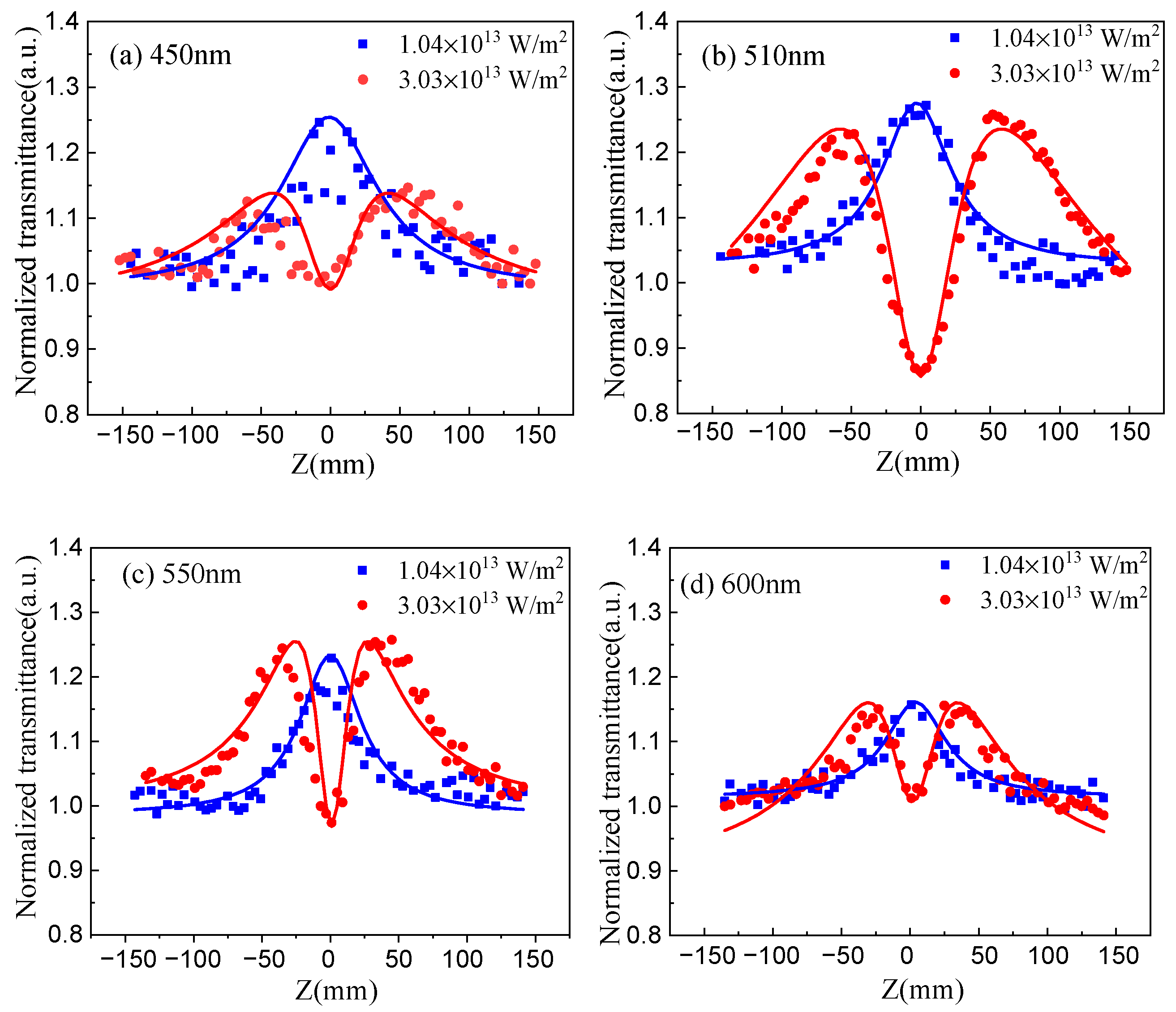Wavelength-Dependent Optical Nonlinear Absorption of Au-Ag Nanoparticles
Abstract
1. Introduction
2. Sample and Experiments
3. Results and Discussions
4. Conclusions
Author Contributions
Funding
Institutional Review Board Statement
Informed Consent Statement
Data Availability Statement
Conflicts of Interest
References
- Brus, L. Noble metal nanocrystals: Plasmon electron transfer photochemistry and single-molecule Raman spectroscopy. Acc. Chem. Res. 2008, 41, 1742–1749. [Google Scholar] [CrossRef] [PubMed]
- Mitsui, K.; Handa, Y.; Kajikawa, K. Optical fiber affinity biosensor based on localized surface plasmon resonance. Appl. Phys. Lett. 2004, 85, 4231–4233. [Google Scholar] [CrossRef]
- Cao, J.; Tu, M.H.; Sun, T.; Grattan, K.T.V. Wavelength-based localized surface plasmon resonance optical fiber biosensor. Sens. Actuators B Chem. 2013, 181, 611–619. [Google Scholar] [CrossRef]
- Cobley, C.M.; Chen, J.; Cho, E.C.; Wang, L.V.; Xia, Y. Gold nanostructures: A class of multifunctional materials for biomedical applications. Chem. Soc. Rev. 2010, 40, 44–56. [Google Scholar] [CrossRef]
- Daraee, H.; Eatemadi, A.; Abbasi, E.; Fekri Aval, S.; Kouhi, M.; Akbarzadeh, A. Application of gold nanoparticles in biomedical and drug delivery. Artif. Cell. Nanomed. B 2014, 44, 410–422. [Google Scholar] [CrossRef]
- Hari, M.; Mathew, S.; Nithyaja, B.; Joseph, S.A.; Nampoori, V.P.N.; Radhakrishnan, P. Saturable and reverse saturable absorption in aqueous silver nanoparticles at off-resonant wavelength. Opt. Quantum Electron. 2012, 43, 49–58. [Google Scholar] [CrossRef]
- Nicoletti, O.; de la Peña, F.; Leary, R.K.; Holland, D.J.; Ducati, C.; Midgley, P.A. Three-dimensional imaging of localized surface plasmon resonances of metal nanoparticles. Nature 2013, 502, 80–84. [Google Scholar] [CrossRef]
- Franci, G.; Falanga, A.; Galdiero, S.; Palomba, L.; Galdiero, M. Silver Nanoparticles as Potential Antibacterial Agents. Molecules 2015, 20, 8856–8874. [Google Scholar] [CrossRef]
- Bright, R.M.; Musick, M.D.; Natan, M.J. Preparation and Characterization of Ag Colloid Monolayers. Langmuir 1998, 14, 5695–5701. [Google Scholar] [CrossRef]
- Daniel, M.C.; Astruc, D. Gold nanoparticles: Assembly, supramolecular chemistry, quantum-size-related properties, and applications toward biology, catalysis, and nanotechnology. Chem. Rev. 2004, 104, 293–346. [Google Scholar] [CrossRef]
- Ma, B.M.; Li, P.; Chen, X.H.; Wang, L.L.; Liu, B.H.; Song, T. Gold nano-triangles as saturable absorbers for a dual-wavelength passively Q-switched Nd:GYSGG laser. Laser Phys. 2018, 28, 075802. [Google Scholar] [CrossRef]
- Fletcher, G.; Arnold, M.D.; Pedersen, T.; Keast, V.J.; Cortie, M.B. Multipolar and dark-mode plasmon resonances on drilled silver nano-triangles. Opt. Express 2015, 23, 18002–18013. [Google Scholar] [CrossRef] [PubMed]
- Dharmatti, R.; Phadke, C.; Mewada, A.; Thakur, M.; Pandey, S.; Sharon, M. Biogenic gold nano-triangles: Cargos for anticancer drug delivery. Mater. Sci. Eng. C Mater. 2014, 44, 92–98. [Google Scholar] [CrossRef]
- Hennemann, L.E.; Kolloch, A.; Kern, A.; Mihaljevic, J.; Boneberg, J.; Leiderer, P.; Meixner, A.J.; Zhang, D. Assessing the plasmonics of gold nano-triangles with higher order laser modes. Beilstein J. Nanotech. 2015, 3, 674–683. [Google Scholar] [CrossRef] [PubMed]
- El-Khoury, P.Z.; Khon, E.; Gong, Y.; Joly, A.G.; Abellan, P.; Evans, J.E.; Browning, N.D.; Hu, D.; Zamkov, M.; Hess, W.P. Electric field enhancement in a self-assembled 2D array of silver nanospheres. J. Chem. Phys. 2014, 141, 17593–17602. [Google Scholar] [CrossRef]
- Zhang, W.; Sun, H.; Liu, R.P.; Yue, Z.; Liu, G.H. Analysis of LSPR extinction properties of two-dimensional Au nanoparticles arrays. J. Optoelectron. Laser 2012, 23, 1005–1010. [Google Scholar]
- Skrabalak, S.E.; Chen, J.Y.; Sun, Y.G.; Lu, X.M.; Au, L.; Cobley, C.M.; Xia, Y.N. Gold Nanocages: Synthesis, Properties, and Applications. Acc. Chem. Res. 2008, 41, 1587–1595. [Google Scholar] [CrossRef]
- Sun, H.; Su, J.H.; Meng, Q.S.; Yin, Q.; Chen, L.L.; Gu, W.W.; Zhang, Z.W.; Yu, H.J.; Zhang, P.C.; Wang, S.L.; et al. Cancer Cell Membrane-Coated Gold Nanocages with Hyperthermia-Triggered Drug Release and Homotypic Target Inhibit Growth and Metastasis of Breast Cancer. Adv. Funct. Mater. 2017, 27, 1604300. [Google Scholar]
- Dong, Q.; Wang, X.; Hu, X.; Xiao, L.; Zhang, L.; Song, L.; Xu, M.; Zou, Y.; Chen, L.; Chen, Z. Simultaneous Application of Photothermal Therapy and an Anti-inflammatory Prodrug using Pyrene-Aspirin-Loaded Gold Nanorod Graphitic Nanocapsules. Angew. Chem. 2018, 57, 177–181. [Google Scholar] [CrossRef] [PubMed]
- Azimzadeh, M.; Rahaie, M.; Nasirizadeh, N.; Ashtari, K.; Naderi-Manesh, H. An electrochemical nanobiosensor for plasma miRNA-155, based on graphene oxide and gold nanorod, for early detection of breast cancer. Biosens. Bioelectron. 2016, 77, 99–106. [Google Scholar]
- Liao, J.F.; Li, W.T.; Peng, J.R.; Yang, Q.; He, L.; Wei, Y.Q.; Zhang, X.N.; Qian, Z.Y. Combined Cancer Photothermal-Chemotherapy Based on Doxorubicin/Gold Nanorod-Loaded Polymersomes. Nanoscale 2015, 5, 345–356. [Google Scholar] [CrossRef]
- Tsai, M.F.; Chang, S.H.G.; Cheng, F.Y.; Shanmugam, V.; Cheng, Y.S.; Su, C.H.; Yeh, C.S. Au Nanorod Design as Light-Absorber in the First and Second Biological Near-Infrared Windows for in Vivo Photothermal Therapy. ACS Nano 2013, 7, 5330–5342. [Google Scholar] [CrossRef]
- Zijlstra, P.; Paulo, P.M.R.; Orrit, M. Optical detection of single non-absorbing molecules using the surface plasmon resonance of a gold nanorod. Nat. Nanotechnol. 2012, 7, 379–382. [Google Scholar] [CrossRef]
- Wei, Y.; Wang, P.J.; Fang, Y. Preparation of Au@Ag Core-Shell Nanorods and Investigation of its Surface Plasmon. Adv. Mater. Res. 2012, 535–537, 446–449. [Google Scholar]
- Ho-Wu, R.; Sahu, P.K.; Wu, N.; Chen, T.; Iii, T.G. Understanding the Optical Properties of Au@Ag Bimetallic Nanoclusters Through Time-Resolved and Nonlinear Spectroscopy. J. Phys. Chem. C 2018, 122. [Google Scholar] [CrossRef]
- Sakthisabarimoorthi, A.; Dhas, S.A.M.B.; Jose, M. Preparation of composite Ag@Au core-shell nanoparticles and their linear and nonlinear optical properties. J. Mater. Sci. Mater. Electron. 2019, 30, 1677–1685. [Google Scholar] [CrossRef]
- Fang, Z.; Cai, J.; Yan, Z.; Nordlander, P.; Halas, N.J.; Zhu, X. Removing a wedge from a metallic nanodisk reveals a Fano resonance. Nano Lett. 2011, 11, 4475–4479. [Google Scholar] [CrossRef] [PubMed]
- Cong, C.; Wu, D.J.; Liu, X.J.; Li, B. Study on the localized surface plasmon resonance properties of bimetallic gold and silver three-layered nanotubes. Acta Phys. Sin. 2012, 61, 37301. [Google Scholar]
- Chaudhuri, R.G.; Paria, S. Core/shell nanoparticles: Classes, properties, synthesis mechanisms, characterization, and applications. Chem. Rev. 2012, 112, 2373–2433. [Google Scholar] [CrossRef]
- Fu, X.; Wu, Z.; Lei, M.; Zhang, L.; Chen, H.; Tang, W.; Peng, Z. A facile route to silver-cadmium sulfide core-shell nanoparticles and their nonlinear optical properties. Mater. Lett. 2013, 104, 76–79. [Google Scholar] [CrossRef]
- Sakthisabarimoorthi, A.; Jose, M.; Martin Britto Dhas, S.A.; Jerome Das, S. Fabrication of Cu@Ag core-shell nanoparticles for nonlinear optical applications. J. Mater. Sci. Mater. Electron. 2016, 28, 4545–4552. [Google Scholar] [CrossRef]
- Karimipour, M.; Ebrahimi, M.; Abafat, Z.; Molaei, M. Synthesis of Ag@TiO2 core-shells using a rapid microwave irradiation and study of their nonlinear optical properties. Opt. Mater. 2016, 57, 257–263. [Google Scholar] [CrossRef]
- Sakthisabarimoorthi, A.; Martin Britto Dhas, S.A.; Jose, M. Fabrication and nonlinear optical investigations of SiO2@Ag core-shell nanoparticles. Mater. Sci. Semicon. Proc. 2017, 71, 69–75. [Google Scholar] [CrossRef]
- Choi, Y.; Hong, S.; Liu, L.; Kim, S.K.; Park, S. Galvanically replaced hollow Au-Ag nanospheres: Study of their surface plasmon resonance. Langmuir ACS J. Surf. Colloids 2012, 28, 6670–6676. [Google Scholar] [CrossRef]
- Monga, A.; Pal, B. Improved catalytic activity and surface electro-kinetics of bimetallic Au-Ag core-shell nanocomposites. New J. Chem. 2015, 39, 304–313. [Google Scholar] [CrossRef]
- Shim, S.; Pham, X.H.; Cha, M.G.; Lee, Y.S.; Jeong, D.H.; Jun, B.H. Size effect of gold on Ag-coated Au nanoparticle-embedded silica nanospheres. RSC Adv. 2016, 6, 48644–48650. [Google Scholar] [CrossRef]
- Lin, S.; Lin, X.; Han, S.Q.G.W.; Zhao, H.Y.; Hasi, W.L.J.; Wang, L. Highly monodisperse Au@Ag nanospheres: Synthesis by controlled etching route and size-dependent SERS performance of their surperlattices. Nanotechnology 2019. [Google Scholar] [CrossRef]
- Lv, H.; Sun, L.; Feng, J.; Na, J.; Xu, D.; Yamauchi, Y.; Liu, B. Plasmonic mesoporous AuAg nanospheres with controllable nanostructures. Chem. Commun. 2020. [Google Scholar] [CrossRef]
- Sheik-Bahae, M.; Said, A.A.; Wei, T.H.; Hagan, D.J.; Van Stryland, E.W. Sensitive measurement of optical nonlinearities using a single beam. IEEE J. Quantum Electron. 1990, 26, 760–769. [Google Scholar] [CrossRef]
- Smith, D.D.; Yoon, Y.; Boyd, R.W.; Campbell, J.K.; Baker, L.A.; Crooks, R.M.; George, M.A. Z-scan measurement of the nonlinear absorption of a thin gold film. J. Appl. Phys. 1999, 86, 6200–6205. [Google Scholar] [CrossRef]
- Wiley, B.; Sun, Y.G.; Mayers, B.; Xia, Y.N. Shape-controlled synthesis of metal nanostructures: The case of silver. Chem. Eur. J. 2005, 11, 454–463. [Google Scholar] [CrossRef]
- West, R.; Wang, Y.; Goodson, T. Nonlinear absorption properties in novel gold nanostructured topologies. J. Phys. Chem. B 2003, 107, 3419–3426. [Google Scholar] [CrossRef]
- Li, J.; Liu, S.; Liu, Y.; Zhou, F.; Li, Z.Y. Anisotropic and enhanced absorptive nonlinearities in a macroscopic film induced by aligned gold nanorods. Appl. Phys. Lett. 2010, 96, 263103. [Google Scholar] [CrossRef]
- Liaros, N.; Fourkas, J.T. The characterization of absorptive nonlinearities. Laser Photonics Rev. 2017, 11, 1700106. [Google Scholar] [CrossRef]
- Wu, W.Z.; Chai, Z.J.; Gao, Y.C.; Kong, D.G.; He, F.; Meng, X.H.; Wang, Y.G. Carrier dynamics and optical nonlinearity of alloyed CdSeTe quantum dots in glass matrix. Opt. Mater. Express 2017, 7, 1547–1556. [Google Scholar] [CrossRef]
- Höller, R.P.M.; Jahn, I.J.; Cialla-May, D.; Chanana, M.; Popp, J.; Fery, A.; Kuttner, C. Biomacromolecular-Assembled Nanoclusters: Key Aspects for Robust Colloidal SERS Sensing. ACS Appl. Mater. Interfaces 2020. [Google Scholar] [CrossRef]




| Wavelength (nm) | E (μJ) | I0 (W/m2) | IS (W/m2) | β (m/W) |
|---|---|---|---|---|
| 450 | 260 | 1.04 × 1013 | 4.32 × 1011 | 0 |
| 760 | 3.03 × 1013 | 2.16 × 1012 | 0.79 × 10−11 | |
| 510 | 260 | 1.04 × 1013 | 4.15 × 1011 | 0 |
| 760 | 3.03 × 1013 | 2.02 × 1012 | 1.3 × 10−11 | |
| 550 | 260 | 1.04 × 1013 | 4.51 × 1011 | 0 |
| 760 | 3.03 × 1013 | 2.33 × 1012 | 1.24 × 10−11 | |
| 600 | 260 | 1.04 × 1013 | 5.46 × 1011 | 0 |
| 760 | 3.03 × 1013 | 3.06 × 1012 | 0.94 × 10−11 |
Publisher’s Note: MDPI stays neutral with regard to jurisdictional claims in published maps and institutional affiliations. |
© 2021 by the authors. Licensee MDPI, Basel, Switzerland. This article is an open access article distributed under the terms and conditions of the Creative Commons Attribution (CC BY) license (https://creativecommons.org/licenses/by/4.0/).
Share and Cite
Wang, J.; Shao, Y.; Chen, C.; Wu, W.; Kong, D.; Gao, Y. Wavelength-Dependent Optical Nonlinear Absorption of Au-Ag Nanoparticles. Appl. Sci. 2021, 11, 3072. https://doi.org/10.3390/app11073072
Wang J, Shao Y, Chen C, Wu W, Kong D, Gao Y. Wavelength-Dependent Optical Nonlinear Absorption of Au-Ag Nanoparticles. Applied Sciences. 2021; 11(7):3072. https://doi.org/10.3390/app11073072
Chicago/Turabian StyleWang, Jun, Yabin Shao, Chunyu Chen, Wenzhi Wu, Degui Kong, and Yachen Gao. 2021. "Wavelength-Dependent Optical Nonlinear Absorption of Au-Ag Nanoparticles" Applied Sciences 11, no. 7: 3072. https://doi.org/10.3390/app11073072
APA StyleWang, J., Shao, Y., Chen, C., Wu, W., Kong, D., & Gao, Y. (2021). Wavelength-Dependent Optical Nonlinear Absorption of Au-Ag Nanoparticles. Applied Sciences, 11(7), 3072. https://doi.org/10.3390/app11073072







